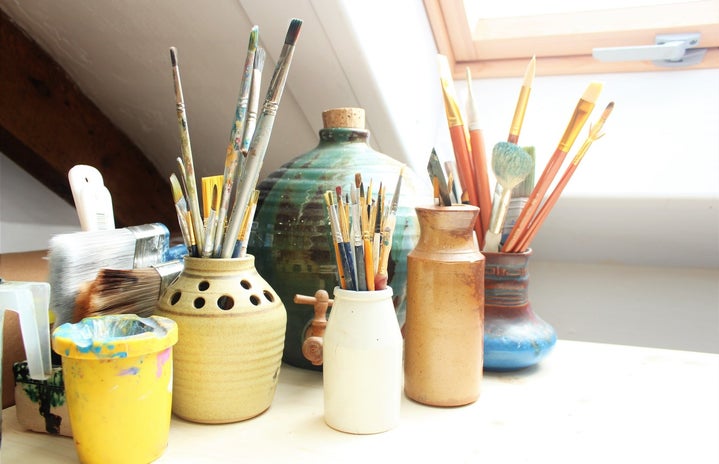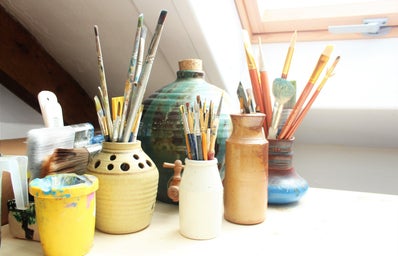What do you think of when you hear ‘sculpture’? Marble statues of Greek deities? Bronze casts of leaders on horseback? How about towering suits made of thrift store finds, completely obscuring the wearer as they dance to the sound of local musicians. These are ‘Soundsuits’, Nick Cave’s signature work. His work can be found in museums internationally, including the nearby Seattle Art Museum. Cave’s work has inspired many, even being the main influence on Crystal Methyd’s ‘The Color Purple’ runway look on RuPaul’s Drag Race season 12. Besides being innovative and inspiring works of art, Cave’s pieces also speak on existing as a minority in American society.
Nick Cave was born in 1959 in Fulton, Missouri, living in a multi-generational home as brother number three of seven. The women of his family had powerful influences on him. His mom supported the family on a single income, his aunts were seamstresses, and his grandma a quilter. When receiving hand-me-downs, Cave used these influences to customize the clothing. Because of that, Cave says he “was already in that process of cutting and putting things back together and finding a new vocabulary through dress.” Cave began teaching at the School of the Art Institute of Chicago in 1989, empowering young artists to reach their potential. Along with teaching, he operates an art factory, as in a dedicated creative and exhibition space, known as FACILITY in Chicago. Cave prides himself on being messenger first, artist second, inspiring others to create and calling people to action.
Nick Cave takes much of his inspiration from Black culture. In his youth, high school loved Ebony and Jet magazines, as they were “the first place we saw people of color with style and power and money and vision.” He also enjoyed the ballroom scene, where Black youths could walk down the runway, using fashion and performance to express their identities. As a young adult, Cave lost friends in the AIDS crisis and was rattled by the rampant denial in American culture. This transformed his perspective, especially when combined with the effects of double consciousness, how Black Americans navigate to survive within white society. Cave’s inspirations are key to understanding his art.
The first Soundsuit was created in reaction to police brutality, specifically the Los Angeles Police Department beating Rodney King in 1991. Cave was shocked: “I felt like my identity and who I was as a human being was up for question. I felt like that could have been me. Once that incident occurred, I was existing very differently in the world. So many things were going through my head: How do I exist in a place that sees me as a threat?” After the officer were acquitted, Cave felt isolated while surrounded by his white coworkers who could not understand his distress. Sitting in the park outside his classroom, he began to gather twigs, “something that was discarded, dismissed, viewed as less. And it became the catalyst for the first Soundsuit.”
Soundsuits combine sculpture, fashion, and performance. Their aesthetics can range from animalistic to ornate, elevating cheap materials and traditional crafts to high art. Nick Cave’s process starts with an object. This object is often found by chance, outside of the studio. Spur of the moment, Nick Cave and his team travel across the country strictly to thrifting. Cave considers how the materials are assembled, drape, move, and work together, but he builds his sculptures off impulse, advising, “Don’t ever overthink it, ‘cause then you kill it.” The finished product is quite the eclectic sight. Soundsuit, 2011, for example, consists of a vintage bunny, safety pin craft baskets, hot pads, fabric metal and stands over nine feet tall. The all-encompassing nature of the Soundsuits means they obscure race, class and gender of the performer. For Cave, the Soundsuits were the answer to his most important question: “What do I do to protect my spirit in spite of all that’s happening around me?” When wearing a Soundsuit, what remains is the individual’s inward identity as outward expression.
Community outreach is an important aspect of Nick Cave’s work. He collaborates with local musicians and choreographers to create Soundsuit performances. To involve the community more, these performances will be done in public, or Cave’s museums exhibitions will host free weekends. For example, Cave’s recent exhibit in the Guggenheim Museum, Nick Cave: Forothermore, had a free opening weekend. Cave stated, “I’m always thinking about how do I get it out into the world? We still have a large public population that doesn’t frequent museums. I’m trying to think of ways to bring awareness, to do my part as an artist with a civic responsibility in connecting the dots.” His FACILITY also frequently hosts art competitions and grants scholarships to students in the Chicago area. As community has been an influence on his own art, Cave gives back to his community through his art.
Nick Cave is an artist who has used his experiences to create groundbreaking work. Coming from humble beginnings, he collected skills and sources of inspiration. In an especially dark time, he expressed his need for security by through the first Soundsuit. Using unconventional processes with each suit, Cave also reaches out to his community to foster others’ creativity. Art is a powerful tool for expression. As Cave once said, “Honey, the question is, how do you want to exist in the world, and how are you going to do the work?”

